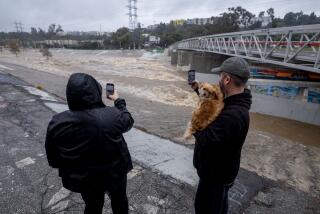The end of California’s drought could mean fewer cases of West Nile virus
Researchers say the end of California’s drought could offer a surprising benefit: reduced transmission of the mosquito-borne West Nile virus.
Drought is the most important weather-related factor that affects the rate of West Nile infection, scientists say. Mosquito eggs need water to hatch, but dry conditions tend to spur greater transmission of the virus.
“Ironically, when we have drought conditions, that does seem to amplify the West Nile virus transmission cycle,” said Vicki Kramer, chief of the Vector-Borne Disease Section at the California Department of Public Health.
West Nile is transmitted between mosquitoes and birds. People can become infected if bitten by an infected mosquito. (The illness is rarely transmitted from one person to another.)
It’s not clear why drought makes it easier for the virus to spread. One possibility is that drought forces mosquitoes and birds into closer proximity around the few remaining sources of water. That would increase the chance of infection.
Another possible explanation is that dry conditions tax birds’ immune systems, leaving them more vulnerable to infection.
Invasive mosquitoes are spreading across Los Angeles County. Have you been bitten? »
In 2015, the number of severe West Nile infections — known as “neuroinvasive” cases — in California hit their highest level since officials began tracking the virus. That was in the middle of the state’s worst drought in more than 500 years.
Then, as the dry conditions eased, the number of cases declined by 75% over the next three years.
Researchers focus on the number of neuroinvasive West Nile virus cases — which are accompanied by meningitis, encephalitis or acute flaccid paralysis — because people who are infected are very likely to get tested. Fewer than 1% of those infected suffer severe symptoms.
Most people with the virus experience only mild symptoms, and they may get tested only if public concern about the disease is running high.
Scientists and public health officials say that while drought plays a significant role in increasing the rate of infection, other factors — especially the extent of human immunity — are also important and can cut the other way, making it hard to predict infection rates from year to year. More people have immunity following years with high infection rates, and that can help reduce the number of new infections.
Last year, 10 people died in California from complications of West Nile virus, down from 44 in 2017.
Nationally, the number of severe West Nile cases in the U.S. increased slightly last year to 1,594, with 137 deaths.
Over the long term, scientists fear that infection rates could rise around the country as climate change makes drought conditions more likely.
“In high drought years, it could be about three times as high as the current average,” said Marm Kilpatrick, a disease ecologist at UC Santa Cruz who published a paper on the link between West Nile virus and drought in 2017.
This story was produced by Kaiser Health News, which publishes California Healthline, an editorially independent service of the California Health Care Foundation. It is not affiliated with Kaiser Permanente.






